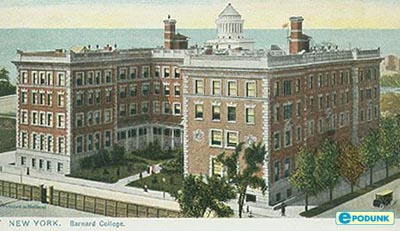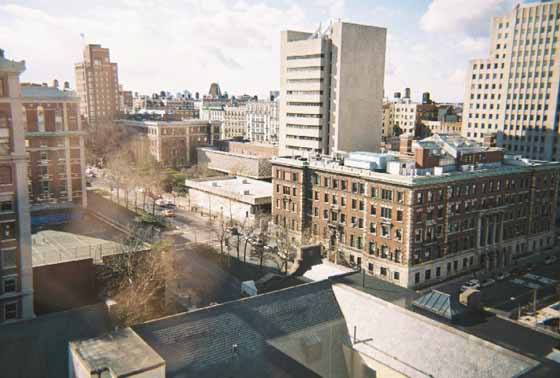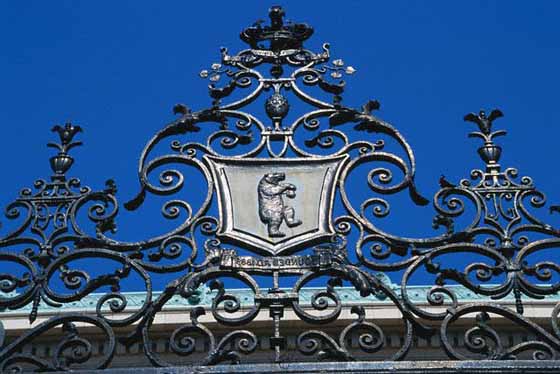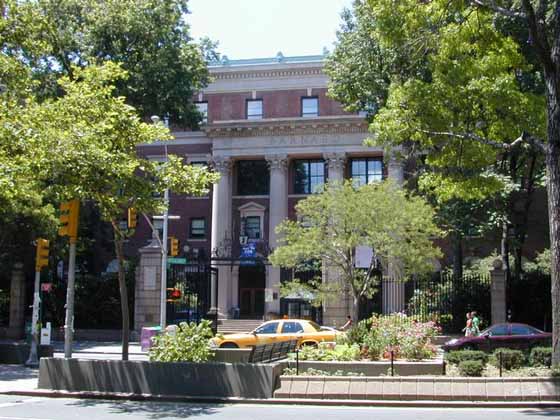 |
New York
Architecture Images-Harlem and the Heights Barnard College |
|
architect |
|
|
location |
West 120th Street |
|
date |
[1896-98] |
|
style |
Beaux-Arts |
|
construction |
brick, limestone trim |
|
type |
Education |
 |
|
|
|
 |
|
images |
 |
|
|
 |
|
Founded as a women's college by Frederick
Barnard--a president of Columbia College and a champion for women's
rights--Barnard College was established as a liberal arts college for
women. It was meant to offer a post-secondary education to the women of
New York for whom, as late as the 1870s, higher education had been
inaccessible.
Occupying only a brownstone on Madison Avenue in its early years, Barnard lacked both land and financial resources. The college moved to its present site, across Broadway from Columbia College, after an extensive fundraising campaign provided the school with a sizable endowment. Whereas its first female students lived at home and were taught by Columbia instructors, today Barnard has its own dormitories and academic staff. |
|
|
Private college of liberal arts and sciences
for women; affiliated with Columbia University
Major bachelor degree programs: Social sciences, English, psychology, visual and performing arts, ethnic studies
Well-known students have included: Sports teams: Lions |
|
|
Four characteristics
distinguish Barnard College: It is a liberal arts college with a long
tradition of excellence; it is part of a great research university; it
is in New York City, and it is a college for women. Each aspect of the
College offers students unique distinctive learning opportunities. The
effect is transformative.
Enrolled at Barnard are 2,300 undergraduates from throughout the nation, 48 states and 35 countries, who take degrees in about 50 fields in the humanities, social sciences, arts, natural sciences, and interdisciplinary areas. Eleven percent of Barnard students are African-American or Latina. Twenty percent are Asian. The College is known for the achievement of its graduates. Barnard ranks third among more than 1,000 undergraduate colleges for the number of graduates who earned Ph.D.'s between 1920 and 1995; first among graduates of chemistry programs who go on to teach chemistry at the college level; and its 29,000 graduates have written over 3,000 books and earned seven Pulitzer Prizes. Barnard is a highly
selective institution; in 2002, 3,686 applicants applied for 543 places,
and 1,269 were admitted. The deadline for regular applications is
January 1.
At Barnard, intense intellectual discussions don't end at classroom doors, but spill out into hallways, faculty offices, and dorm rooms. Barnard students are excited about ideas and aren't afraid to take intellectual and creative risks, whether the topic is economics, 18th-century American literature, oceanography, Latin American politics, ethnography, or Taoism. Two hundred ninety-two faculty members animate the adventure both in the classroom and on a personal level. They open new doors for students, involving them in their own research, pointing out unrealized strengths, suggesting new approaches, listening, and guiding - but ultimately allowing each student to make her own discoveries. More than two-thirds of the courses that Barnard offers have fewer than 20 students. The faculty includes editors of leading scholarly journals, prize-winning novelists and translators, and frequent winners of awards from respected foundations, corporations and government agencies, including the National Science Foundation, the Ford Foundation and the Andrew W. Mellon Foundation. In the past two years, Barnard faculty members were awarded 85 grants totaling about $9 million. The faculty includes: Mark Carnes, co-editor of the 23,040-page American national Biography; Demetrios James Caraley, president of the Academic of Political Science, Anne Prescott, author of Imagining Rabelais in Renaissance England; James Basker, president of the Gilder Lerhman Institute of American History; and Rae Silver, president of the Society for Research in biological Rhythms. Through Barnard's General Education program, each student receives an education of both depth and breadth, that builds skills of analysis, independent thought, and self-expression. Students take First-Year Seminar, First-year English, and courses fulfilling the nine Ways of Knowing: Reason and Value, Social Analysis, Cultures in Comparison, Language, Laboratory Science, Quantitative and Deductive Reasoning, Historical Studies, Literature, and Visual and Performing Arts. President Judith Shapiro notes the requirements "successfully capture the mission of the college to provide an excellent liberal arts education that is intellectually focused, challenging, and responsive to emerging developments in scholarship, pedagogy, and society." To help Barnard students
navigate through the extraordinary range of academic choices available
to them, the College has developed an advising system that puts students
in close contact with faculty members immediately and throughout their
college experience. The academic adviser follows and guides each
student's progress during the first two years, explaining curricular
requirements, writing recommendations for internships or study abroad
programs, listening to concerns, and helping her match courses to her
goals interests. Advice at Barnard is both formal and informal and can
come from many sources - class deans, faculty members, residence hall
directors, and peers, among others. All are committed to helping each
student determine her future direction.
Barnard's 2,300 students and 292 faculty members are a vital part of the University community, which includes about 5,700 undergraduates and about 11,300 graduate students in more than 15 graduate and professional divisions. Each year, Barnard faculty, who are tenured both by Barnard and Columbia, teach about 40 graduate courses at the University. Cross-registration flows across Broadway in both directions, allowing Barnard and Columbia students to take classes on either campus. In a typical year, there are 6,900 Barnard student course registrations at Columbia, and 6,300 Columbia student course registrations at Barnard. Highly motivated Barnard students may take graduate-level courses at Columbia in such as international affairs, business, law, and arts and sciences. Barnard provides education to all university undergraduates in architecture, dance, education, theater, and urban studies, while programs in music, the visual arts, computer science, and engineering are centered at Columbia. Barnard women also take leadership positions in many Columbia-sponsored organizations, from the Spectator, the nation's second-oldest student daily, to spearheading Community Impact, an umbrella volunteer action group. In the sports arena, Barnard varsity athletes compete in intercollegiate athletics through the Columbia University/Barnard College Athletic Consortium at the NCAA Division I Level in 14 sports (archery, basketball, crew, cross-country, fencing, field hockey, indoor track and field, lacrosse, outdoor track and field, soccer, softball, swimming and diving, tennis and volleyball), and in the Ivy League. In the Barnard-Columbia community - always lively, on the move, and definitely coeducational - the ambiance is active, diversified, and highly charged. With several educational and social environments at their fingertips, Barnard students can create their own paths. For more information on the
Barnard-Columbia partnership,
click here.
For Barnard students, New York City is a living text. The College weaves the city into its courses and into the course of daily life. The faculty's involvement with New York makes it easy to call on other experts to lead classes or trade ideas. The exchange between College and city works both ways. In Barnard's own neighborhood, students can take courses at Manhattan School of Music or work toward a second bachelor's degree - in Hebrew Literature - from the Jewish Theological Seminary. Farther afield, at Lincoln Center, The Juilliard School offers instruction to especially talented musicians and, to a few, the chance to earn a master's in music along with a bachelor's degree from Barnard. Eventually, if not initially, Barnard students are cultured, streetwise, self-assured. That kind of savvy comes with attending a college located in New York City and committed to the achievements of women. The College's involvement
with the city means extraordinary intellectual and cultural
opportunities. Barnard students enjoy curricular links and internships
with the best New York can offer: law (firms and organizations such as
Sullivan & Cromwell and the Legal Aid Society), medicine (Columbia
Presbyterian Hospital, Sloan-Kettering), finance (the New York Stock
Exchange, Chase Manhattan Bank), publishing (giants such as
HarperCollins and Random House as well as numerous small houses),
journalism (The New York Times, CNN), art (the Museum of Modern Art, the
Metropolitan Museum of Art, the Guggenheim, and many of the nation's
most important and influential private galleries), and international
relations (the United Nations), among others.
Barnard students soon discover that their classmates are among the principal resources of their undergraduate years. Cosmopolitan in nature, the student population includes residents of nearly every state and some 40 foreign countries as well as those who live within commuting distance. One of the few generalizations that can be made safely about Barnard students is that they are diverse; a mingling of economic, regional, ethnic, and cultural groups is evident in campus life. Nine out of ten students live in college housing and participate in the educational programs, cultural events, and social activities of their residence halls. More than half of the faculty are women, well above the national average. All of them - men as well as women - believe that the potential contributions of women should be encouraged, recognized, and realized. Women have led Barnard from the beginning, from Ella Weed in 1889 to anthropologist Judith Shapiro today. Barnard graduates reflect the College's reputation for instilling confidence and high aspirations. They include; Maria Hinojosa '84, CNN Urban Affairs correspondent; Ellen Futter '74, president of the American Museum of Natural History and the former president of Barnard; Phyllis Grann '58, president and CEO of Penguin Putnam; Jacqueline Barton '74, professor of chemistry at the California Institute of Technology and a MacArthur Fellow; Sheila Nevins '60, executive director of programming for HBO; choreographer Twyla Tharp '63; and Anna Quindlen '74, Newsweek columnist, journalist and novelist Additional information: |
|
|
links |
http://www.barnard.columbia.edu/ |